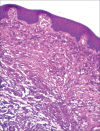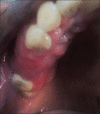Polymorphous adenocarcinoma of the oral cavity: A skeptical case mimicking lobular carcinoma of breast and gastric carcinoma
- PMID: 29491608
- PMCID: PMC5824520
- DOI: 10.4103/jomfp.JOMFP_203_17
Polymorphous adenocarcinoma of the oral cavity: A skeptical case mimicking lobular carcinoma of breast and gastric carcinoma
Abstract
Polymorphous adenocarcinoma (PAC) is a distinctive salivary gland neoplasm that predominantly occurs in the minor salivary glands. The tumor is characterized by cytological uniformity, morphological diversity, an infiltrative growth pattern and low metastatic potential. It presents as an asymptomatic, slow- growing mass within the oral cavity. This salivary gland tumor is difficult to diagnose both clinically and histopathologically due to its indolent presentation and diverse architectural pattern which includes various microscopic patterns namely- solid, ductal-tubular, cribriform, trabecular and single-file growth. Hence, Immunohistochemistry plays a very important role in diagnosing this tumor. We hereby report a rare case of PAC occurring in a 50yr old female patient presenting with a lesion in right upper posterior part of alveolus extending to the hard palate.
Keywords: Immunohistochemical analysis; Indian file pattern; polymorphous low-grade adenocarcinoma.
Conflict of interest statement
There are no conflicts of interest.
Figures













Similar articles
-
Lobular carcinoma of the breast metastatic to the oral cavity mimicking polymorphous low-grade adenocarcinoma of the minor salivary glands.Arch Pathol Lab Med. 2000 Jan;124(1):157-9. doi: 10.5858/2000-124-0157-LCOTBM. Arch Pathol Lab Med. 2000. PMID: 10629151
-
Polymorphous low-grade adenocarcinoma of the salivary glands with transformation to high-grade carcinoma.Histopathology. 2002 Sep;41(3):250-9. doi: 10.1046/j.1365-2559.2002.01439.x. Histopathology. 2002. PMID: 12207787
-
Polymorphous adenocarcinoma: A case report along with its characteristics and diagnostic challenges.J Oral Maxillofac Pathol. 2021 Sep-Dec;25(3):517-522. doi: 10.4103/jomfp.JOMFP_286_20. Epub 2022 Jan 11. J Oral Maxillofac Pathol. 2021. PMID: 35281157 Free PMC article.
-
Polymorphous Low-Grade Adenocarcinoma of the Salivary Glands - A Review.Niger Med J. 2022 Apr 25;62(2):49-53. eCollection 2021 Mar-Apr. Niger Med J. 2022. PMID: 38505574 Free PMC article. Review.
-
Polymorphous Adenocarcinoma.Surg Pathol Clin. 2021 Mar;14(1):127-136. doi: 10.1016/j.path.2020.09.011. Epub 2021 Jan 5. Surg Pathol Clin. 2021. PMID: 33526217 Free PMC article. Review.
Cited by
-
Polymorphous Adenocarcinoma: A Systematic Review of the Literature and Presentation of Two Cases in a Less-Considered Anatomical Site.Cancers (Basel). 2024 Jan 3;16(1):220. doi: 10.3390/cancers16010220. Cancers (Basel). 2024. PMID: 38201647 Free PMC article. Review.
References
-
- Evans HL, Batsakis JG. Polymorphous low-grade adenocarcinoma of minor salivary glands. A study of 14 cases of a distinctive neoplasm. Cancer. 1984;53:935–42. - PubMed
-
- Batsakis JG, Pinkston GR, Luna MA, Byers RM, Sciubba JJ, Tillery GW, et al. Adenocarcinomas of the oral cavity: A clinicopathologic study of terminal duct carcinomas. J Laryngol Otol. 1983;97:825–35. - PubMed
-
- Freedman PD, Lumerman H. Lobular carcinoma of intraoral minor salivary gland origin. Report of twelve cases. Oral Surg Oral Med Oral Pathol. 1983;56:157–66. - PubMed
-
- Waldron CA, el-Mofty SK, Gnepp DR. Tumors of the intraoral minor salivary glands: A demographic and histologic study of 426 cases. Oral Surg Oral Med Oral Pathol. 1988;66:323–33. - PubMed
Publication types
LinkOut - more resources
Full Text Sources
Other Literature Sources

